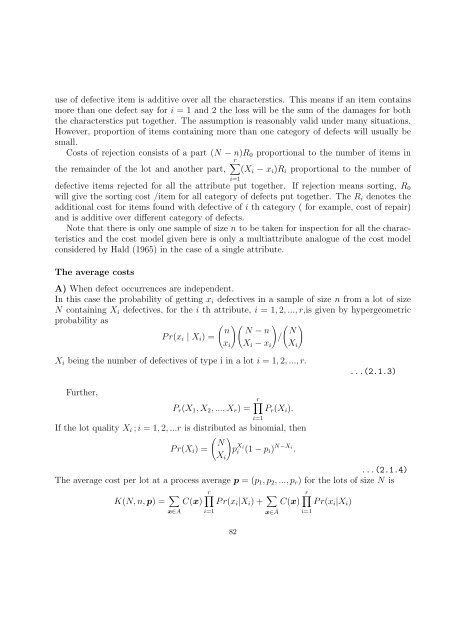Multiattribute acceptance sampling plans - Library(ISI Kolkata ...
Multiattribute acceptance sampling plans - Library(ISI Kolkata ...
Multiattribute acceptance sampling plans - Library(ISI Kolkata ...
You also want an ePaper? Increase the reach of your titles
YUMPU automatically turns print PDFs into web optimized ePapers that Google loves.
use of defective item is additive over all the characterstics. This means if an item contains<br />
more than one defect say for i = 1 and 2 the loss will be the sum of the damages for both<br />
the characterstics put together. The assumption is reasonably valid under many situations.<br />
However, proportion of items containing more than one category of defects will usually be<br />
small.<br />
Costs of rejection consists of a part (N − n)R 0 proportional to the number of items in<br />
r∑<br />
the remainder of the lot and another part, (X i − x i )R i proportional to the number of<br />
i=1<br />
defective items rejected for all the attribute put together. If rejection means sorting, R 0<br />
will give the sorting cost /item for all category of defects put together. The R i denotes the<br />
additional cost for items found with defective of i th category ( for example, cost of repair)<br />
and is additive over different category of defects.<br />
Note that there is only one sample of size n to be taken for inspection for all the characteristics<br />
and the cost model given here is only a multiattribute analogue of the cost model<br />
considered by Hald (1965) in the case of a single attribute.<br />
The average costs<br />
A) When defect occurrences are independent.<br />
In this case the probability of getting x i defectives in a sample of size n from a lot of size<br />
N containing X i defectives, for the i th attribute, i = 1, 2, ..., r,is given by hypergeometric<br />
probability as<br />
( )( ) ( )<br />
n N − n N<br />
P r(x i | X i ) =<br />
/<br />
x i X i − x i X i<br />
X i being the number of defectives of type i in a lot i = 1, 2, ..., r.<br />
...(2.1.3)<br />
Further,<br />
r∏<br />
P r (X 1 , X 2 , ..., X r ) = P r (X i ).<br />
i=1<br />
If the lot quality X i ; i = 1, 2, ...r is distributed as binomial, then<br />
( ) N<br />
X i<br />
P r(X i ) =<br />
p X i<br />
i (1 − p i ) N−X i<br />
.<br />
...(2.1.4)<br />
The average cost per lot at a process average p = (p 1 , p 2 , ..., p r ) for the lots of size N is<br />
K(N, n, p) = ∑ r∏<br />
C(x) P r(x i |X i ) + ∑ r∏<br />
C(x) P r(x i |X i )<br />
x∈A i=1 x∈Ā i=1<br />
82
















